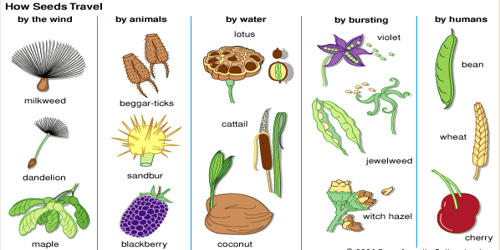In addition to protecting the embryo, the fruit plays an important role in seed dispersal. Without favorable conditions, the seed does not germinate. Again without a favorable environment, no seedling can grow big. If all the fruits or seeds of a plant fall directly under the mother tree, then many of them will fail to germinate, for want of space, water, light, and air, many of the germinated ones may die because of the shade of the plants. The rest survivors will gradually perish. So for maintaining the existence and increasing of a generation of plants in the favourable environment dispersal of fruits and seeds is essential. When dispersed to new environments, plants have the opportunity to adapt to the location’s conditions. These adaptations will also ensure the prolonged survival of the plant on Earth.
Some fruits are carried from one place to another by human beings for their own interest e.g. Litchi, Mango, Jackfruit, etc. In some plants fruits and seeds remains just under the tree. Again in some plants fruits and seeds are taken away from the mother plant by various agents and are distributed to distant areas. This process of distribution of fruits and seeds to a distant area from its mother plant by several means is called dispersal of fruits and seeds.
Importance of Fruit and Seed Dispersal – Seed dispersion is the most important phenomenon that occurs with the help of different agents such as wind, water, and animals. It ensures the survival of the plant species should an environment become uninhabitable due to construction, pollution, alien species, etc.
- Seed dispersal is the moving of seeds to a new location. This helps move genetic information away from the parent plant into new and uncharted territory.
- This encourages aforestation because plants grow in new places. Protection from predators also less competition for sunlight, water, and nutrient.
- It prevents overcrowding of plants. If all the fruits and seeds fall under the parent plant, ail may not be able to germinate to develop seedling.
- It reduces competition among fruits and seeds for sunlight, water, and other soil minerals. Seedlings will not get sufficient light and air for normal living.
- Soil nutrition will be insufficient for them as these have been mostly used up by the parent plant, and there will be sharing of the existing nutrition present in the soil.
- A group of the same type of seedling will be developed under the parent plant. It reduces the spread of epidemic diseases among crowded plant species.











